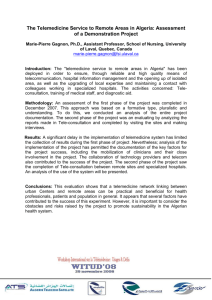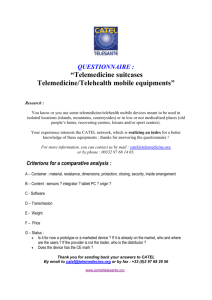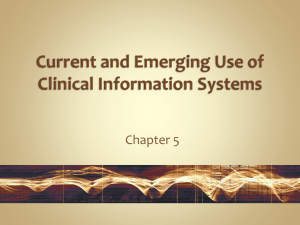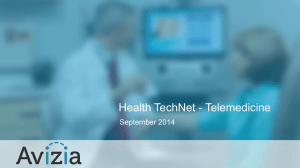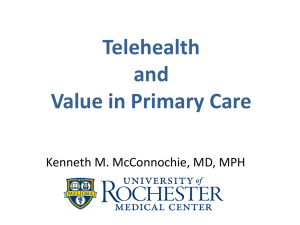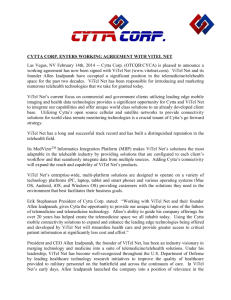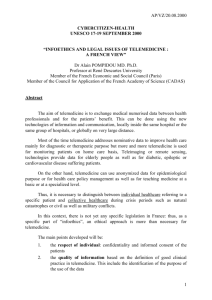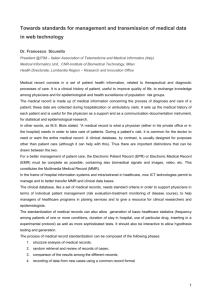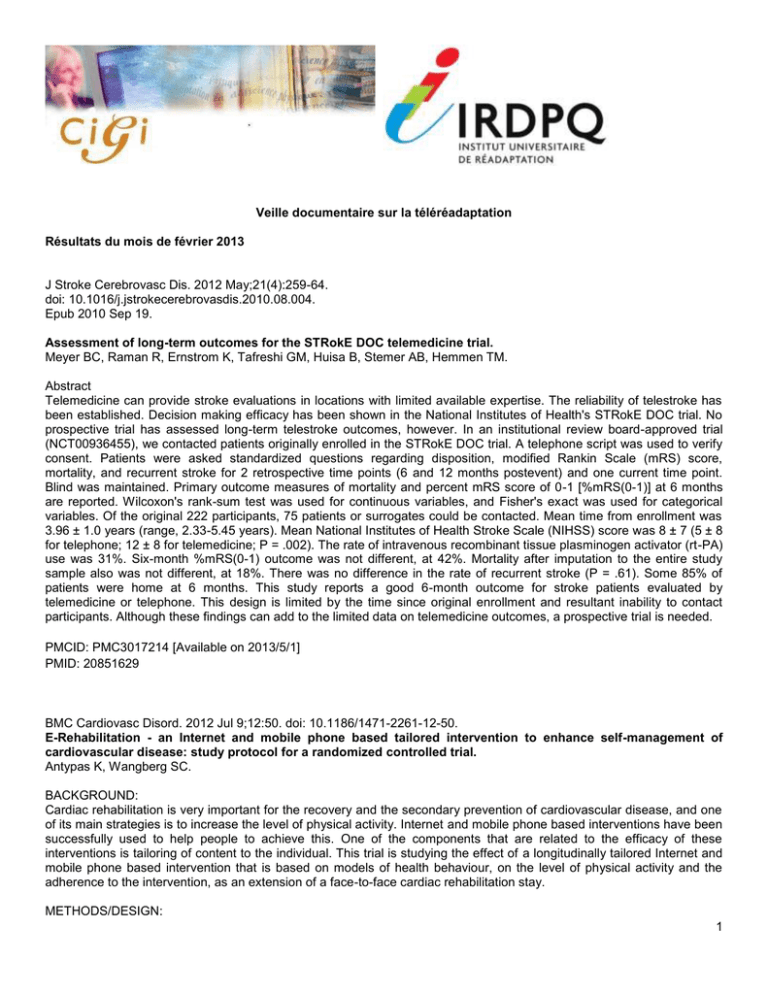
Veille documentaire sur la téléréadaptation
Résultats du mois de février 2013
J Stroke Cerebrovasc Dis. 2012 May;21(4):259-64.
doi: 10.1016/j.jstrokecerebrovasdis.2010.08.004.
Epub 2010 Sep 19.
Assessment of long-term outcomes for the STRokE DOC telemedicine trial.
Meyer BC, Raman R, Ernstrom K, Tafreshi GM, Huisa B, Stemer AB, Hemmen TM.
Abstract
Telemedicine can provide stroke evaluations in locations with limited available expertise. The reliability of telestroke has
been established. Decision making efficacy has been shown in the National Institutes of Health's STRokE DOC trial. No
prospective trial has assessed long-term telestroke outcomes, however. In an institutional review board-approved trial
(NCT00936455), we contacted patients originally enrolled in the STRokE DOC trial. A telephone script was used to verify
consent. Patients were asked standardized questions regarding disposition, modified Rankin Scale (mRS) score,
mortality, and recurrent stroke for 2 retrospective time points (6 and 12 months postevent) and one current time point.
Blind was maintained. Primary outcome measures of mortality and percent mRS score of 0-1 [%mRS(0-1)] at 6 months
are reported. Wilcoxon's rank-sum test was used for continuous variables, and Fisher's exact was used for categorical
variables. Of the original 222 participants, 75 patients or surrogates could be contacted. Mean time from enrollment was
3.96 ± 1.0 years (range, 2.33-5.45 years). Mean National Institutes of Health Stroke Scale (NIHSS) score was 8 ± 7 (5 ± 8
for telephone; 12 ± 8 for telemedicine; P = .002). The rate of intravenous recombinant tissue plasminogen activator (rt-PA)
use was 31%. Six-month %mRS(0-1) outcome was not different, at 42%. Mortality after imputation to the entire study
sample also was not different, at 18%. There was no difference in the rate of recurrent stroke (P = .61). Some 85% of
patients were home at 6 months. This study reports a good 6-month outcome for stroke patients evaluated by
telemedicine or telephone. This design is limited by the time since original enrollment and resultant inability to contact
participants. Although these findings can add to the limited data on telemedicine outcomes, a prospective trial is needed.
PMCID: PMC3017214 [Available on 2013/5/1]
PMID: 20851629
BMC Cardiovasc Disord. 2012 Jul 9;12:50. doi: 10.1186/1471-2261-12-50.
E-Rehabilitation - an Internet and mobile phone based tailored intervention to enhance self-management of
cardiovascular disease: study protocol for a randomized controlled trial.
Antypas K, Wangberg SC.
BACKGROUND:
Cardiac rehabilitation is very important for the recovery and the secondary prevention of cardiovascular disease, and one
of its main strategies is to increase the level of physical activity. Internet and mobile phone based interventions have been
successfully used to help people to achieve this. One of the components that are related to the efficacy of these
interventions is tailoring of content to the individual. This trial is studying the effect of a longitudinally tailored Internet and
mobile phone based intervention that is based on models of health behaviour, on the level of physical activity and the
adherence to the intervention, as an extension of a face-to-face cardiac rehabilitation stay.
METHODS/DESIGN:
1
A parallel group, cluster randomized controlled trial. The study population is adult participants of a cardiac rehabilitation
programme in Norway with home Internet access and mobile phone, who in monthly clusters are randomized to the
control or the intervention condition. Participants have access to a website with information regarding cardiac
rehabilitation, an online discussion forum and an online activity calendar. Those randomized to the intervention condition,
receive in addition tailored content based on models of health behaviour, through the website and mobile text messages.
The objective is to assess the effect of the intervention on maintenance of self-management behaviours after the
rehabilitation stay. Main outcome is the level of physical activity one month, three months and one year after the end of
the cardiac rehabilitation programme. The randomization of clusters is based on a true random number online service,
and participants, investigators and outcome assessor are blinded to the condition of the clusters.
DISCUSSION:
The study suggests a theory-based intervention that combines models of health behaviour in an innovative way, in order
to tailor the delivered content. The users have been actively involved in its design, and because of the use of OpenSource software, the intervention can easily and at low-cost be reproduced and expanded by others. Challenges are the
recruitment in the elderly population and the possible underrepresentation of women in the study sample. Funding by
Northern Norway Regional Health Authority.
PMID: 22776554
PMCID: PMC3483248 Free PMC Article
Technological Advances in the Treatment of Trauma: A Review of Promising Practices
Paul, Lisa A; Hassija, Christina M Clapp, Joshua D Gray, Matt J Lombardo, Thomas W.
Behavior modification 36. 6 (2012): 897-923.
Given the availability of empirically supported practices for addressing posttraumatic stress disorder and other forms of
trauma-related distress, the development and implementation of new technology to deliver these treatments is
exciting.Technological innovations in this literature aim to expand availability of empirically based intervention, increase
treatment adherence and acceptability, and overcome barriers commonly encountered with conventional trauma-focused
treatment. Much of the current research on these technological developments consists of brief reviews and case studies
of the separate therapy modalities. Although this work serves to document the appeal and utility of these innovations, it
does not provide comprehensive information about the host of options available.To that end, the three general categories
of technological advances in trauma therapy (i.e., videoconferencing, e-Health, virtual reality) are reviewed here, including
information regarding their empirical support and suggestions for future research and clinical practice.
ISSN 0145-4455
ID de document ProQuest 1283263256
URL du document http://search.proquest.com/docview/1283263256?accountid=12008
Base de données FRANCIS
Telemedicine--a complement to traditional referrals in oral medicine.
Blomstrand L., Sand L.P., Gullbrandsson L., Eklund B., Kildal M., Hirsch J.M.
Telemed J E Health 2012 18:7 (549-553)
MEDLINE
Abstract
Introducing telemedicine into clinical practice has not been without difficulties. Within the framework of the European
Union project "Health Optimum," telemedicine consultations with specialists at the Department of Oral & Maxillofacial
Surgery at Uppsala University Hospital (Uppsala, Sweden) have been offered to dentists in the public dental health
service. The aim is to streamline the consultation process, improve/develop the skills of the participating dentists and
dental hygienists, and save time and money for patients, healthcare authorities, and society. Patient records are collected
in a database for demonstration and discussion, and the system is also available for referrals. Both medical and dental
photographs and x-rays are digitized in the same system. These can be viewed during telemedicine rounds and by the
consultants at the hospital prior to a consultation. Secure, interactive conferencing software is used, which provides a
quick, easy, and effective way to share video and data over the Internet. Both parties can demonstrate different parts of
an image using a pointer or a drawing system. Conference phones are presently used for verbal communication. Ten
patients were discussed during telemedicine rounds (3 males and 7 females), all of whom would normally have been
2
referred to a specialist. As a result of the telemedicine round, 2 were referred to a specialist, whereas diagnoses were
made for the other 8, and treatment was suggested. The dental health clinic could thus provide treatment without the need
for referral to a consultant. The telemedicine system described here allows patient care to be provided rapidly and more
economically. Future plans include "live" rounds using a videocamera, providing the possibility to relay real-time
information about the intraoral situation. A camera is being developed and should preferably be permanently installed
chair side.
PMID 22823077
Telerehabilitation to improve outcomes for people with stroke: Study protocol for a randomised controlled trial
Saywell N., Vandal A.C., Brown P., Hanger H.C., Hale L., Mudge S., Milosavljevic S., Feigin V., Taylor D.
Trials 2012 13:
Abstract
Background: In New Zealand, around 45,000 people live with stroke and many studies have reported that benefits gained
during initial rehabilitation are not sustained. Evidence indicates that participation in physical interventions can prevent the
functional decline that frequently occurs after discharge from acute care facilities. However, on-going stroke services
provision following discharge from acute care is often related to non-medical factors such as availability of resources and
geographical location. Currently most people receive no treatment beyond three months post stroke. The study aims to
determine if the Augmented Community Telerehabilitation Intervention (ACTIV) results in better physical function for
people with stroke than usual care, as measured by the Stroke Impact Scale, physical subcomponent.Methods/design:
This study will use a multi-site, two-arm, assessor blinded, parallel randomised controlled trial design. People will be
eligible if they have had their first ever stroke, are over 20 and have some physical impairment in either arm or leg, or
both. Following discharge from formal physiotherapy services (inpatient, outpatient or community), participants will be
randomised into ACTIV or usual care. ACTIV uses readily available technology, telephone and mobile phones, combined
with face-to-face visits from a physiotherapist over a six-month period, to help people with stroke resume activities they
enjoyed before the stroke. The impact of stroke on physical function and quality of life will be assessed, measures of cost
will be collected and a discrete choice survey will be used to measure preferences for rehabilitation options. These
outcomes will be collected at baseline, six months and 12 months. In-depth interviews will be used to explore the
experiences of people participating in the intervention arm of the study.Discussion: The lack of on-going rehabilitation for
people with stroke diminishes the chance of their best possible outcome and may contribute to a functional decline
following discharge from formal rehabilitation. Best practice guidelines recommend a prolonged period of rehabilitation,
however this is expensive and therefore not undertaken in most publicly funded centres. An effective, cost-effective, and
preference-sensitive therapy using basic technology to assist programme delivery may improve patient autonomy as they
leave formal rehabilitation and return home.Trial registration: ACTRN12612000464864. © 2012 Saywell et al.; licensee
BioMed Central Ltd.
Stroke. 2012 Dec;43(12):3271-7. doi: 10.1161/STROKEAHA.112.669150. Epub 2012 Nov 15.
Reliability of real-time video smartphone for assessing National Institutes of Health Stroke Scale scores in acute
stroke patients.
Demaerschalk BM, Vegunta S, Vargas BB, Wu Q, Channer DD, Hentz JG.
Abstract
BACKGROUND AND PURPOSE:
Telestroke reduces acute stroke care disparities between urban stroke centers and rural hospitals. Current technologies
used to conduct remote patient assessments have high start-up costs, yet they cannot consistently establish quality timely
connections. Smartphones can be used for high-quality video teleconferencing. They are inexpensive and ubiquitous
among health care providers. We aimed to study the reliability of high-quality video teleconferencing using smartphones
for conducting the National Institutes of Health Stroke Scale (NIHSS).
METHODS:
Two vascular neurologists assessed 100 stroke patients with the NIHSS. The remote vascular neurologist assessed
subjects using smartphone videoconferencing with the assistance of a bedside medical aide. The bedside vascular
neurologist scored patients contemporaneously. Each vascular neurologist was blinded to the other's NIHSS scores. We
tested the inter-method agreement and physician satisfaction with the device.
RESULTS:
3
We demonstrated high total NIHSS score correlation between the methods (r=0.949; P<0.001). The mean total NIHSS
scores for bedside and remote assessments were 7.93±8.10 and 7.28±7.85, with ranges, of 0 to 35 and 0 to 37,
respectively. Eight categories had high agreement: level of consciousness (questions), level of consciousness
(commands), visual fields, motor left and right (arm and leg), and best language. Six categories had moderate agreement:
level of consciousness (consciousness), best gaze, facial palsy, sensory, dysarthria, and extinction/inattention. Ataxia had
poor agreement. There was high physician satisfaction with the smartphone.
CONCLUSIONS:
Smartphone high-quality video teleconferencing is reliable, easy to use, affordable for telestroke NIHSS administration,
and has high physician satisfaction.
PMID: 23160878
Clin Interv Aging. 2012;7:445-51. doi: 10.2147/CIA.S36461. Epub 2012 Nov 2.
The impact of telemonitoring upon hospice referral in the community: a randomized controlled trial.
Takahashi PY, Hanson GJ, Thorsteinsdottir B, Van Houten HK, Shah ND, Naessens JM, Pecina JL.
Abstract
BACKGROUND:
Using telemedicine for older adults with multiple comorbid conditions is a potential area for growth in health care. Given
this older, ailing population, providers should discuss end-of-life care with patients.
OBJECTIVE:
To determine the relationship between telemonitoring and hospice enrollment compared to usual care among older adults
with chronic health problems.
METHODS:
This was a secondary evaluation of a randomized controlled trial. The trial was performed at an academic medical center.
Patients who were over the age of 60 and had a high risk of hospitalization and emergency department visits were
recruited to the study. The primary outcome was hospice enrollment, and the secondary outcome was the mean number
of days in hospice. The data were analyzed using Chi-squared tests and time-to-event analysis.
RESULTS:
The average age of the cohort was 80.3 years. Nine patients (9.6%) in the telemonitoring group were enrolled in hospice
care, whereas four patients (4.0%) in the usual care group were enrolled (P = 0.12). The mean number of days in hospice
was 57.9 (SD ± 99.2) for the telemonitoring group, and 119.3 (SD ± 123.8) for the usual care group (P = 0.36). There was
no significant difference regarding time to hospice referral.
CONCLUSION:
In this pilot analysis, there were no differences noted between groups in the number of patients that entered into hospice
or the amount of time they stayed in hospice care. This was a small trial, and the power to detect a difference was 36%. It
was encouraging that twice the number of patients enrolled in hospice care in the telemonitoring group compared to usual
care despite the insignificant finding. Further research may determine the effect of telemonitoring upon hospice referral.
PMCID: PMC3496193 Free PMC Article
PMID: 23152674
Crit Care Nurs Q. 2012 Oct-Dec;35(4):364-77. doi: 10.1097/CNQ.0b013e318266bc26.
Different systems and formats for tele-ICU coverage: designing a tele-ICU system to optimize functionality and
investment.
Reynolds HN, Bander J, McCarthy M.
Abstract
Technology always changes, yet change or evolution within the tele-ICU has been slow. In developing a modern
telemedicine system to manage acute illness, there are several concepts the developer/administrator should consider to
include "scalability," centralized/decentralized systems, open/closed architecture, inclusivity of the medical community,
mobile technology, price set, and governmental regulation. The intent of this manuscript is to apply these concepts to
current tele-ICU technology, explain the concepts in some depth, and finally, to speculate as to how the future tele-ICU
might look.
PMID: 22948371
Crit Care Nurs Q. 2012 Oct-Dec;35(4):357-63. doi: 10.1097/CNQ.0b013e318266bdf5.
How to develop a tele-ICU model?
4
Rogove H.
Abstract
The concept of the tele-ICU (intensive care unit) is about 30 years old and more hospitals are utilizing it to cover multiple
hospitals in their system or for hospitals that lack on-site critical care coverage such as in the rural setting. Doing a needs
analysis, picking the appropriate committee to oversee development of the correct model, choosing quality metrics to
measure, and designing an implementation plan that has a timeline is how the process should begin. Research including
visitation to established programs and connecting with professional societies are helpful. Developing both a business and
financial plan will optimize the value of a tele-ICU program. The innovative ICU nursing director will help to integrate a
telemedicine program seamlessly with the on-site program to insure a successful program that benefits patients, their
families, the ICU staff, and the hospital.
PMID: 22948370
Crit Care Nurs Q. 2012 Oct-Dec;35(4):353-6.
Professional accountability in the tele-ICU: the CCRN-E.
Davis TM, Barden C, Olff C, Aust MP, Seckel MA, Jenkins CL, Deibert W, Griffin P, Herr P, Hawkins C, McCarthy M.
The American Association of Critical-Care Nurses (AACN) is the world's largest specialty nursing organization. The AACN
Certification Corporation provides credentialing to validate nursing practice in acute and critical care. The advent of teleICU nursing added a challenge to the application of certification in a new specialty area. Nurses working in a tele-ICU
have many years of experience in hands-on acute or critical care nursing at the bedside. In their role as tele-ICU nurses,
these skills are applied to the assessment, evaluation, and decision support of care for critically ill patients in various
acute and critical care units from remote locations connected directly to the ICU through high-speed audio and video
technology. This article outlines the journey of the advent of the CCRN-E (registered nurse in critical care) credential and
its place in the new specialty of tele-ICU nursing practice.
PMID: 22948369
Crit Care Nurs Q. 2012 Oct-Dec;35(4):346-52. doi: 10.1097/CNQ.0b013e318266bed1.
Building a telehealth network through collaboration: the story of the Nebraska statewide telehealth network.
Meyers L, Gibbs D, Thacker M, Lafile L.
Abstract
With the recent governmental focus on increasing broadband capabilities throughout the nation, with rapid advances in
technology, and with other regulatory and reimbursement barriers falling, a great number of sites across the United States
are in the process of either initiating or expanding their Telehealth capabilities. The Nebraska Statewide Telehealth
Network, one of the most comprehensive networks in the nation, is no exception. Built through a collaborative effort of
hospitals, health departments, the Nebraska Hospital Association, and other organizations, the Network's members
include nearly every hospital and health department in the State. The Nebraska Statewide Telehealth Network has been
awarded more than $1.4 million in grant funding since 2008 and, last year, provided 3633 clinical consultations to rural
residents across the State.Among its many benefits, Telehealth increases access to specialty care for patients in rural
areas; decreases travel time and saves money for patients and caretakers alike; provides the potential for earlier disease
intervention; enhances clinical support between specialists and primary care providers; and serves as a medium for easy
access to professional education, training, and collaboration. And, now, this technology is becoming increasingly mobile,
allowing practitioners the opportunity to connect anywhere. In a rural state dominated by Health Care Professional
Shortage Areas and Medically Underserved Areas, Telehealth has the opportunity to help patients receive care at home.
PMID: 22948368
Crit Care Nurs Q. 2012 Oct-Dec;35(4):341-5. doi: 10.1097/CNQ.0b013e318266c2f2.
Video consultation for trauma and emergency surgical patients.
Joseph B, Hadeed G, Sadoun M, Rhee PM, Weinstein RS.
Abstract
The saying goes that a picture is worth a thousand words, but what then is the value of video? For the care of trauma and
emergency surgical patients, the use of video consultation between medical providers may be worth its weight in gold.
Telemedicine has become an important tool in reducing the disparity among the haves and the have not's, in this case
facilities with a trauma service and those without. This article presents the use of live video for trauma consultations
5
between the only level 1 trauma center in Southern Arizona and several smaller rural hospitals. We also expand on what
we believe the future and direction of telesurgery in the fields of critical care and trauma surgery.
PMID: 22948367
Crit Care Nurs Q. 2012 Oct-Dec;35(4):335-40. doi: 10.1097/CNQ.0b013e318266bfd1.
Integration of evidence-based knowledge management in microsystems: a tele-ICU experience.
Rincon TA.
Abstract
The Institute of Medicine's proposed 6 aims to improve health care are timely, safe, effective, efficient, equitable, and
patient-centered care. Unfortunately, it also asserts that improvements in these 6 dimensions cannot be achieved within
the existing framework of care systems. These systems are based on unrealistic expectations on human cognition and
vigilance, and demonstrate a lack of dependence on computerized systems to support care processes and put information
at the point of use. Knowledge-based care and evidence-based clinical decision-making need to replace the unscientific
care that is being delivered in health care. Building care practices on evidence within an information technology platform is
needed to support sound clinical decision-making and to influence organizational adoption of evidence-based practice in
health care. Despite medical advances and evidence-based recommendations for treatment of severe sepsis, it remains a
significant cause of mortality and morbidity in the world. It is a complex disease state that has proven difficult to define,
diagnose, and treat. Supporting bedside teams with real-time knowledge and expertise to target early identification of
severe sepsis and compliance to Surviving Sepsis Campaign, evidence-based practice bundles are important to
improving outcomes. Using a centralized, remote team of expert nurses and an open-source software application to
advance clinical decision-making and execution of the severe sepsis bundle will be examined.
PMID: 22948366
Crit Care Nurs Q. 2012 Oct-Dec;35(4):322-7. doi: 10.1097/CNQ.0b013e3182684f67.
Use of change management theories in gaining acceptance of telemedicine technology.
Rufo RZ.
Abstract
The success of telemedicine applications within health care begins with the process of implementing planned change. The
attitudes of staff and their willingness to embrace new technology can be positively influenced in order to gain acceptance
of new ways to perform tasks. Telemedicine applications have been designed to improve operational efficiency and obtain
improved outcomes, but system designers and procurers are dependent upon the organization's leadership to effect
attitudinal and behavioral changes that are essential for acceptance and usage of new technology.
PMID: 22948364
BMC Med Res Methodol. 2012 May 17;12:69. doi: 10.1186/1471-2288-12-69.
From theory to 'measurement' in complex interventions: methodological lessons from the development of an ehealth normalisation instrument.
Finch TL, Mair FS, O'Donnell C, Murray E, May CR.
BACKGROUND:
Although empirical and theoretical understanding of processes of implementation in health care is advancing, translation
of theory into structured measures that capture the complex interplay between interventions, individuals and context
remain limited. This paper aimed to (1) describe the process and outcome of a project to develop a theory-based
instrument for measuring implementation processes relating to e-health interventions; and (2) identify key issues and
methodological challenges for advancing work in this field.
METHODS:
A 30-item instrument (Technology Adoption Readiness Scale (TARS)) for measuring normalisation processes in the
context of e-health service interventions was developed on the basis on Normalization Process Theory (NPT). NPT
focuses on how new practices become routinely embedded within social contexts. The instrument was pre-tested in two
health care settings in which e-health (electronic facilitation of healthcare decision-making and practice) was used by
health care professionals.
RESULTS:
6
The developed instrument was pre-tested in two professional samples (N=46; N=231). Ratings of items representing
normalisation 'processes' were significantly related to staff members' perceptions of whether or not e-health had become
'routine'. Key methodological challenges are discussed in relation to: translating multi-component theoretical constructs
into simple questions; developing and choosing appropriate outcome measures; conducting multiple-stakeholder
assessments; instrument and question framing; and more general issues for instrument development in practice contexts.
CONCLUSIONS:
To develop theory-derived measures of implementation process for progressing research in this field, four key
recommendations are made relating to (1) greater attention to underlying theoretical assumptions and extent of translation
work required; (2) the need for appropriate but flexible approaches to outcomes measurement; (3) representation of
multiple perspectives and collaborative nature of work; and (4) emphasis on generic measurement approaches that can
be flexibly tailored to particular contexts of study.
PMCID: PMC3473304 Free PMC Article
PMID: 22594537
Pain Pract. 2012 Sep;12(7):570-7. doi: 10.1111/j.1533-2500.2012.00534.x. Epub 2012 Feb 5.
A comprehensive review of telehealth for pain management: where we are and the way ahead.
McGeary DD, McGeary CA, Gatchel RJ.
Department of Psychiatry, The University of Texas Health Science Center San Antonio, San Antonio, Texas 78229, USA.
mcgeary@uthscsa.edu
Comment in • Calling all pain patients: telehealth has arrived. [Pain Pract. 2012]
Abstract
Pain is generally undertreated in the United States, owing to a number of barriers including geographic distance from
specialty treatment providers; functional disability that limits mobility; treatment-related stigma; economic limitations; and
educational barriers. Pain undertreatment exacerbates pain chronicity and emotional disruption that can significantly
erode a pain patient's quality of life, and there is widespread agreement that pain care must evolve to address this
significant problem. The growing field of telehealth (defined for the purposes of this paper as technology that allows for
distance interaction between providers and/or patients) offers a novel opportunity to expand pain assessment,
consultation, and treatment services beyond the walls of the specialty pain clinic, but there is limited availability of
resources describing how to best use this technology to improve access to care. A recent literature review (September
2011) using universally endorsed MeSH search criteria revealed only 32 MEDLINE references focusing on telehealth for
pain. This is surprising in light of the very large number of references covering telehealth (14,164 references) and pain
(104,564 references), respectively. Of the studies available, there are very few randomized trials of telehealth pain care
and only one general overview of e-health and chronic pain, which dedicates just a few paragraphs to telehealth. This
manuscript represents one of the first comprehensive reviews of the current state of telehealth and pain management
research and practice. The goals are to provide a rationale for the potential benefit of telehealth-based pain management
services; describe the various applications of telehealth technology for pain management; orient the reader to cost models
for telehealth; present examples of services in place; and offer recommendations for future research based on the current
state of knowledge.
PMID: 22303839
Telemedicine for the support of parents of high-risk newborn infants.
Tan K. and Lai N.M.
Cochrane database of systematic reviews (Online) 2012 6 (CD006818)
Telemedicine is the use of electronic communications technology to provide care for patients when distance separates the
practitioner and the patient. As the parents and families of infants admitted to the NICU require major support from health
professionals in terms of information and time, telemedicine has the potential to increase this support. To evaluate if the
use of telemedicine technology to support families of newborn infants receiving intensive care affects the length of
hospital stay and parental/family satisfaction. We searched the following databases: Cochrane Central Register of
Controlled Trials (CENTRAL, The Cochrane Library, 2011, Issue 8), MEDLINE (from 1966 to September 2011), EMBASE
(1980 to September 2011). We also searched ClinicalTrials.gov (http://www.clinicaltrials.gov) and the EudraCT
(http://eudract.emea.eu.int) web sites. We searched the proceedings of conferences of the Canadian Society of
Telehealth, American Telemedicine Association, the International Society for Telemedicine, the Annual Conference of The
International e-Health Association, American Medical Informatics Association and MedInfo. We attempted to identify
randomised controlled trials that assessed the use of telemedicine designed to support parents of infants cared for in a
Neonatal Intensive Care Unit (NICU) compared with standard support measures. Our primary outcome was the length of
hospital stay, and secondary outcomes included parental and staff satisfaction, emergency hospital visits post-discharge
7
and family utilisation of infant health-related resources. Two review authors independently screened the studies, extracted
the data and assessed the risk of bias of the one included study using the standard methods of the Cochrane Neonatal
Review Group. We planned to express treatment effects as risk ratio (RR), risk difference (RD), number needed to treat
(NNT) and mean difference (MD) where appropriate, using a fixed-effect model. A single study was included for analysis
in this review. This study compared the use of telemedicine (Baby Carelink) for parents and families of infants in the NICU
with a control group without access to this programme and assessed the length of hospital stay for the infants and family
satisfaction in multiple components of infant care. The study shows no difference in the length of hospital stay (average
length of stay: telemedicine group: 68.5 days (standard deviation (SD) 28.3 days), control group: 70.6 days (SD 35.6
days), MD -2.10 days (95% confidence interval: -18.85 to 14.65 days). There was insufficient information for further
analysis of measures of family satisfaction. There is insufficient evidence to support or refute the use of telemedicine
technology to support the parents of high-risk newborn infants receiving intensive care. Clinical trials are needed to
assess the application of telemedicine to support parents and families of infants in NICU with length of hospital stay and
their perception of NICU care as the major outcomes.
L366378573
Telehealth & the role of technology in future patient care.
Brackett C.
Caring : National Association for Home Care magazine 2012 31:10 (14-17)
Set against the backdrop of global healthcare reform--which is being enabled and driven by technology--new telehealth
solutions are earning their mettle by cutting costs throughout the care continuum, improving the quality of patient care,
and giving patients greater access to the healthcare services and providers they need. But is telehealth truly the answer to
the pain points plaguing the healthcare industry?
L366376132
Strong authentication scheme for telecare medicine information systems.
Pu Q., Wang J. and Zhao R.
Journal of medical systems 2012 36:4 (2609-2619)
The telecare medicine information system enables or supports health-care delivery services. A secure authentication
scheme will thus be needed to safeguard data integrity, confidentiality, and availability. In this paper, we propose a
generic construction of smart-card-based password authentication protocol and prove its security. The proposed
framework is superior to previous schemes in three following aspects : (1) our scheme is a true two-factor authentication
scheme. (2) our scheme can yield a forward secure two-factor authentication scheme with user anonymity when
appropriately instantiated. (3) our scheme utilizes each user's unique identity to accomplish the user authentication and
does not need to store or verify others's certificates. And yet, our scheme is still reasonably efficient and can yield such a
concrete scheme that is even more efficient than previous schemes. Therefore the end result is more practical for the
telecare medicine system.
L366376292
Integrating telehealth and the EHR. Organizations make progress remotely linking physicians and patients, but
documenting the remote consult will require much integration work.
Prestigiacomo J.
Healthcare informatics : the business magazine for information and communication systems 2012 29:6 (60, 62-63)
Here's a look at several HRSA Office for Advancement of Telehealth grantee organizations and their recommendations for
what CIOs, CTOs, and CMIOs need to do to achieve integration and interoperability in telehealth.
L366375010
The utility of multimedia in the diagnosis and management of acute and subacute problems in hand surgery.
Althubaiti G., Buntic R. and Brooks D.
Annals of plastic surgery 2012 68:4 (389-390)
A typical consultation is based on a phone conversation between the consulting service and the surgeon. If the description
given to the surgeon misrepresents the severity of the condition, unnecessary transfer of the patient could follow. In an
attempt to reduce the occurrence of unnecessary transfers, we started supplementing our consultation with video
captured with a cell phone camera demonstrating specific points in clinical examination of the hand. These videos were
sent to the surgeon to clarify the clinical picture. We found this method useful in some cases in ruling out the need for
urgent transfer.
8
L366375016
Telemedicine as a means of effective speech evaluation for patients with cleft palate.
Whitehead E., Dorfman V., Tremper G., Kramer A., Sigler A. and Gosman A.
Annals of plastic surgery 2012 68:4 (415-417)
Providing long-term multidisciplinary care for cleft lip/palate is a challenge for international humanitarian organizations that
perform surgery across borders. The use of telemedicine as a means of evaluating speech in patients with cleft lip/palate
has not been studied previously. We looked at determining whether a speech evaluation performed by a speech-language
pathologist (SLP) using telemedicine would be equivalent to a speech evaluation performed in-person, in an international
setting between Tijuana, Mexico and San Diego, CA. Spanish-speaking SLPs developed an informal protocol to evaluate
several speech characteristics. Patients were simultaneously evaluated by 2 SLPs, one in-person in Tijuana and the other
over telemedicine videoconference from San Diego, CA. In addition, we obtained data regarding the parents experience
with telemedicine through a satisfaction survey. Results showed no statistically significant differences between the 2
methods of speech evaluation, particularly in oral muscle tone, resonance, lingual lateralization, oral pressure, and
dentition. The satisfaction survey showed family satisfaction with the speech evaluation performed using telemedicine.
Thus, telemedicine represents an effective medium for conducting speech assessment in patients with cleft lip/palate,
allowing for increased access to care for underserved populations.
MEDLINE PMID 22421491
Asthma education via telemedicine: Effects on asthma knowledge and self-efficacy
Burbank A., Rettiganti M., Brown R.H., Jones S. and Perry T.T.
Journal of Investigative Medicine 2012 60:1 (401)
Purpose of Study: Asthma Education via Telemedicine: Effects on Asthma Knowledge and Self-efficacy.
Methods Used: Rural Arkansas Delta children with asthma and their caregivers were randomized to receive either asthma
education via telemedicine or usual care. The intervention group received detailed education regarding asthma
symptoms, proper medication use, asthma triggers, how to identify and handle asthma-related emergencies, and use of
the asthma action plan. The primary care providers of the intervention group received a treatment prompt based on
baseline survey data. Participants who completed all education sessions and both pre/post-intervention surveys were
included in the analysis. Measures observed include age, caregiver asthma knowledge score, child self-efficacy score,
and caregiver self-efficacy score (total score, attack prevention sub-score, and attack management sub-score). Two group
comparisons were performed using the two-sample t-test. Summary of Results: Pre and post-intervention scores for the
primary outcomes were measured and expressed as mean values. The caregiver self-efficacy attack prevention subscores were significantly different between the intervention and usual care groups at baseline (t=3.58, p=0.01), with a
higher mean score in the usual care group. There were no other statistically differences between the groups at baseline.
Following intervention, caregiver asthma self-efficacy - attack prevention sub-score was significantly higher in the
intervention group compared to the usual care group (t=-2.48, p=0.03). There were no statistically significant differences
in asthma knowledge or child self-efficacy scores post-intervention between groups.
Conclusions: Caregivers receiving asthma education via telemedicine had a significant improvement in the asthma attack
prevention subscale as compared to the usual care group. Results suggest that asthma education via telemedicine can
potentially improve health outcomes, specifically caregiver asthma self-efficacy, in rural, underserved regions such as the
Arkansas Delta.
Copyright 2013 Elsevier B.V., All rights reserved.
Int Psychogeriatr. 2012 Nov;24(11):1708-24. doi: 10.1017/S1041610212000981. Epub 2012 Jun 12.
Telepsychogeriatrics: a new horizon in the care of mental health problems in the elderly.
Ramos-Ríos R, Mateos R, Lojo D, Conn DK, Patterson T.
BACKGROUND:
The use of telemedicine for the care of mental health problems has developed significantly over the last decade thanks to
the emergence of a number of stable telepsychiatry programs in many countries. Parallel to this development, this care
modality has also targeted specific populations with higher difficulty in gaining access to mental health services such as
the elderly. Telepsychogeriatrics is expected to have an increasing role in providing care to geographically isolated rural
communities, with a particular focus on long-term care facilities, in light of the high prevalence of psychiatric disorders in
these centers and the lack of available specialized care.
9
METHODS:
A thorough search of the literature was conducted using Medline, Web of Science, and PsychINFO databases in order to
gather available evidence on the applicability of telepsychiatry, specifically the use of videoconferencing for remote
consultation, in the elderly population with mental disorders. A succinct description of the selected studies is given along
with a general reflection on the state-of-the-art in the field of psychogeriatric clinical practice and research.
RESULTS:
Research on the use of telemedicine in this age group has taken into account their special characteristics, and has
focused on demonstrating its applicability, the acceptance and satisfaction of elderly users and their healthcare providers,
the possibility of carrying out cognitive and diagnostic assessments, and the efficiency of these programs.
CONCLUSIONS:
Despite limited experience, telepsychogeriatrics appears to be a viable option, well accepted by patients, including those
having dementia. More systematized studies are needed in this new field based on larger sample sizes, including
comparison with traditional consultations and assessment of the clinical outcomes
PMID: 22687259
Maturitas. 2012 Oct;73(2):94-114. doi: 10.1016/j.maturitas.2012.06.010. Epub 2012 Jul 17.
Telemedicine and telecare for older patients--a systematic review.
van den Berg N, Schumann M, Kraft K, Hoffmann W.
Telemedicine is increasingly becoming a reality in medical care for the elderly. We performed a systematic literature
review on telemedicine healthcare concepts for older patients. We included controlled studies in an ambulant setting that
analyzed telemedicine interventions involving patients aged ≥60 years. 1585 articles matched the specified search
criteria, thereof, 68 could be included in the review. Applications address an array of mostly frequent diseases, e.g.
cardiovascular disease (N=37) or diabetes (N=18). The majority of patients is still living at home and is able to handle the
telemedicine devices by themselves. In 59 of 68 articles (87%), the intervention can be categorized as monitoring. The
largest proportion of telemedicine interventions consisted of measurements of vital signs combined with personal
interaction between healthcare provider and patient (N=24), and concepts with only personal interaction (telephone or
videoconferencing, N=14). The studies show predominantly positive results with a clear trend towards better results for
"behavioral" endpoints, e.g. adherence to medication or diet, and self-efficacy compared to results for medical outcomes
(e.g. blood pressure, or mortality), quality of life, and economic outcomes (e.g. costs or hospitalization). However, in 26 of
68 included studies, patients with characteristic limitations for older patients (e.g. cognitive and visual impairment,
communication barriers, hearing problems) were excluded. A considerable number of projects use rather sophisticated
technology (e.g. videoconferencing), limiting ready translation into routine care. Future research should focus on how to
adapt systems to the individual needs and resources of elderly patients within the specific frameworks of the respective
national healthcare systems.
Copyright © 2012 Elsevier Ireland Ltd. All rights reserved.
PMID: 22809497
La Veille en téléréadaptation est une initiative du Comité de développement des pratiques cliniques en
téléréadaptation, coordonné par Johanne Lambert, chargée de projet (IRDPQ)
Recherche documentaire effectuée par Ann Murchison, bibliothécaire, CIGI, IRDPQ
Sélection réalisée par Geneviève Bastien, physiothérapeute et coordonnatrice clinique au Programme des grands
brûlés de la Direction des services à la clientèle adultes-aînés, Louis Deschênes, spécialiste en réadaptation
visuelle au Programme de déficience visuelle de la Direction des services à la clientèle et Ann Murchison,
bibliothécaire
10

